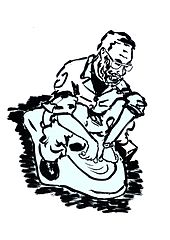Defecation postures

Humans mostly use one of two types of defecation postures to defecate: squatting and sitting. People use the squatting postures when using squat toilets or when defecating in the open in the absence of toilets. The sitting posture on the other hand is used in toilets that have a pedestal or "throne", where users generally lean forward or sit at 90 degrees to a toilet seat.
Sitting

The sitting defecation posture involves sitting with hips and knees at approximately right angles, as on a chair. So-called "Western-style" flush toilets and also many types of dry toilets are designed to be used in a sitting posture.
In Europe, America and other western countries most people are accustomed to sitting toilets,[1] although this fashion has only been present for around 100 years.[1] Sitting toilets only came into widespread use in Europe in the nineteenth century.[2]
Sitting toilets requires users to strain in an unnatural position.
Special devices exist in the form of "wrap-around foot stools" to allow users of western-style toilets to defecate in a posture that is somewhat similar to squatting.[4]
Squatting
The squatting defecation posture involves squatting, or crouching. It requires standing with knees and hips sharply bent and the buttocks close to the ground. Squat toilets are designed to facilitate this posture. Squatting is considered the natural, traditional and most common defecation posture in Asian and African countries.[1] However in some urban areas of India people are gradually switching to western style sitting toilets.[5]
The
Excessive straining in the squatting position while defecating may increase the risk of severe
Semi-squatting
People who are not used to squat toilets, and people who do not have the flexibility, strength, or balance needed to lower into, sustain, or rise from a squatting position without pain or assistance may not find it easy to use the squatting posture. This may include the elderly, people with disabilities, overweight people or people suffering from a skeletal or muscular disease.
A semi-squatting position can be achieved by placing a stool or box under the feet while using a sitting toilet.
For elderly people or people with mobility issues, this "semi-squatting" position is closer to the more natural[3] squatting position,[1] and gives some of the benefit of the squatting position such as reduced need for straining.[3] The semi squatting position is one of the practical solutions for avoiding constipation.[1] Various "squat assist devices" are also commercially available.[1]
See also
- Defecography
- Human positions
References
- ^ PMID 30898031.
- OCLC 490984504
- ^ ISBN 978-3-030-66049-9.
- The Huffington Post.
- ^ PMID 30617919.
- ^ )
- ISBN 978-0-7020-7243-7.
- ISBN 978-3-319-65941-1.
- S2CID 52187439.
